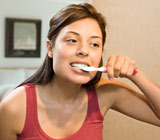Brushing and Flossing – Two Key Elements to Avoiding Dental Disease
 We humans have been cleaning our teeth for millennia. While the tools and substances have changed (we don’t use twigs or pumice anymore), the reasons haven’t: we want a nice, fresh smile and a clean-feeling mouth.
We humans have been cleaning our teeth for millennia. While the tools and substances have changed (we don’t use twigs or pumice anymore), the reasons haven’t: we want a nice, fresh smile and a clean-feeling mouth.
Objectively, though, oral hygiene has one primary purpose — to remove dental plaque, the whitish film of bacteria that grows on unclean tooth surfaces and at the gum line. Removing this decay-causing film can drastically reduce your risk of dental disease.
Effective oral hygiene depends on two primary tasks: brushing and flossing. You should perform these tasks at least once (flossing) or twice (brushing) in a 24-hour period. Brushing involves a simple technique. You hold your toothbrush (a well-designed, multi-tufted brush) in your fingertips with the same pressure as you would a pen or pencil. You then gently scrub all of the tooth surfaces starting at the gum line, holding the brush at a 45-degree. “Gently” is the key word here: it’s possible to damage your tooth and gum surfaces by brushing too vigorously.
While brushing seems easier for people to fit into their daily routine, flossing seems to be harder. It’s just as important, though, because over half of plaque accumulation occurs between teeth, in areas where brushing can miss. Like brushing, flossing isn’t difficult to do. Holding a strip of floss taut by your fingers between both hands, and gently slipping the floss between your teeth you form a “C” shape around each tooth surface as you apply pressure onto the one surface you are cleaning. Gently move the floss up and down for three or four strokes or until you hear a squeaky clean sound (that’s when you know the surface is clean). Then you go to the other tooth surface by lifting the floss above the gum line so that you don’t damage the gum tissue in between the teeth.
You should also schedule regular checkups and cleanings with our office to supplement your daily routine. Professional cleanings remove any hidden plaque that brushing and flossing may have missed. A checkup also gives us a chance to evaluate how well your hygiene program is progressing. Our partnership in proper oral hygiene can make all the difference in you avoiding tooth decay and other dental diseases.
If you would like more information on proper oral hygiene, please contact us for a consultation.
Oral Care Tips for your Toddler
 Caring for a young child can be overwhelming at times. Sometimes, it may feel like you can’t read enough books to learn the correct way to do everything from potty training to feeding. It’s also important to teach your child healthcare habits during these crucial years, so that they continue these habits for a lifetime!
Caring for a young child can be overwhelming at times. Sometimes, it may feel like you can’t read enough books to learn the correct way to do everything from potty training to feeding. It’s also important to teach your child healthcare habits during these crucial years, so that they continue these habits for a lifetime!
Here are a few simple ways you can help your child to institute lifetime oral care habits.
- DO: Encourage your Child to Brush Every Day with Fluoride Toothpaste. Fluoride will help make your child’s teeth more resistant to tooth decay. You should use a thin smear of fluoride toothpaste for children under age two and a pea-sized amount for older children. At age two, you can also begin empowering your child to brush, but make sure that you supervise and finish the job. Your child will probably need your help until around the age of six.
- DON’T: Share your Germs. Did you know that children are not born with the bacteria that cause tooth decay? In fact, the bacteria are transmitted to them from adults! You should never share a cup or spoon with your child. Also, next time you kiss your child, kiss him or her on the cheeks instead of the lips. Believe it or not, you can transmit harmful bacteria through this quick little kiss.
- DO: Limit your Child’s Sugar Intake. When your child consumes sugar, the bacteria use the sugar to produce acids that dissolve tooth enamel, eventually leading to tooth decay. Saliva can neutralize those acids, but it needs enough time, 30 to 60 minutes, to work its magic. That is why it is important to limit sugar intake between meals.
- DON’T: Give Your Child a Bottle at Night. Juice, milk and even breast milk contain sugars that promote tooth decay, in particular during sleep, when less saliva is being produced. So, though it may be tempting, do not let your child go to bed with a bottle.
- DO: Take your Child to the Dentist Early. The American Academy of Pediatric Dentistry recommends that all children have their first dental visit by the age of one. Your toddler will benefit from regular dental visits, because we will monitor tooth decay, correct brushing techniques and also, most importantly, ensure that he or she is comfortable in the dental chair.
- DON’T: Allow your Child to Suck His or Her Thumb Past Age Three. Thumb sucking for comfort is a very normal behavior for babies and toddlers. However, if your child constantly sucks his or her thumb past the age of three, it can affect teeth alignment and jaw development.
If you would like more information on how we can address your problems with sleep apnea, please contact us for a consultation.
Vanna White Talks Dentistry
 Vanna White has been a household name for the last 27+ years and is best known as the first female co-host of the game show, Wheel of Fortune. She radiates a warm, friendly, down-home appeal and says when describing herself, “what you see is what you get!” While this is quite true, there is so much more to her. She has received a star on the famous Hollywood Walk Of Fame, has starred in an NBC movie and written a book. She is even featured in The Guinness Book of World Records as TV’s most frequent clapper, and most recently started her own line of yarn called Vanna’s Choice with half of the proceeds going to St. Jude Children’s Research Hospital. And while any one of these accolades could serve as the highlight of a lifetime for most, for Vanna they fall slightly short. Her favorite job is being mother to her son, Nicholas, and daughter, Giovanna.
Vanna White has been a household name for the last 27+ years and is best known as the first female co-host of the game show, Wheel of Fortune. She radiates a warm, friendly, down-home appeal and says when describing herself, “what you see is what you get!” While this is quite true, there is so much more to her. She has received a star on the famous Hollywood Walk Of Fame, has starred in an NBC movie and written a book. She is even featured in The Guinness Book of World Records as TV’s most frequent clapper, and most recently started her own line of yarn called Vanna’s Choice with half of the proceeds going to St. Jude Children’s Research Hospital. And while any one of these accolades could serve as the highlight of a lifetime for most, for Vanna they fall slightly short. Her favorite job is being mother to her son, Nicholas, and daughter, Giovanna.
The following are excerpts taken from an exclusive interview in Dear Doctor magazine, the premier oral healthcare resource for patients and consumers.
What is the secret to her dazzling smile?
Vanna’s oral healthcare routine is the same today as it has been since her childhood — and one everyone can follow. She brushes her teeth at least twice a day (morning and at bedtime) and flosses her teeth daily. She also has strong feelings about flossing. “I think that flossing is the most important thing. I believe that dental floss helps a lot as it keeps your gums strong and looking younger.”
What about bleaching, has she done it?
Absolutely! Vanna bleaches her teeth once or twice a year to help retain her naturally white teeth and to offset any discoloration from coffee and an occasional glass of red wine. “I have done over-the-counter and professional bleaching, but I do like the trays my dentist made because they fit perfectly.” She also states, “Anything you can do professionally is probably better because I would assume that a dentist’s ingredients are stronger than over-the-counter products.”
Has she had any cosmetic dentistry?
When it comes to answering a question about cosmetic dentistry, Vanna is just as open and honest as she is about everything else — a trait for which she is known. “I had a bridge put in probably 30 years ago, where I had a tooth pulled and there was a space. And I did have a little tiny chip on one of my front teeth years ago that my dentist fixed. But that is it. Again, I feel very fortunate to have good teeth. The braces [from her childhood] straightened them out and there has been no need for any cosmetics since then.”
Does she do anything to protect her teeth?
While she admits to occasionally forgetting to use her nightguard, a protective mouthguard worn during sleep, she firmly believes in their need. “I do sleep in a nightguard because I grind my teeth. I have a filling in the back that probably has been filled five times from grinding.” She added, “Both of my children do have mouthguards that they wear for their sports.”
Want a smile like Vanna’s?
Contact us today discuss your questions about bleaching, cosmetic dentistry or mouthguards.




